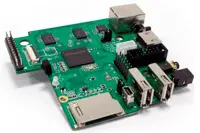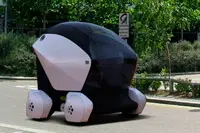Electronics News
Archive : 5 December 2014 год
 In August this year, Imagination Technologies took the wraps off the MIPS Creator C120; a dev board it said would rival the Raspberry Pi and help provide low cost development systems for users looking to create applications based on its IP technologies.
In August this year, Imagination Technologies took the wraps off the MIPS Creator C120; a dev board it said would rival the Raspberry Pi and help provide low cost development systems for users looking to create applications based on its IP technologies.
Nearly four months on, the company has announced that the board is now available to pre-order, with the first shipments beginning in January 2015.
At £50, the Creator will cost nearly double the price of a Raspberry Pi. However, at a press event held in London yesterday, Imagination was keen to stress the additional benefits it will bring to users.
The board, which runs both Linux and Android, packs a dual core, 1.2GHz MIPS32 based processor, PowerVR SGX540 graphics, 1GB DDR3 memory, 4GB flash memory and an SD card expansion slot.
Targeted primarily at Internet of Things applications (surprise, surprise), it also offers dedicated video hardware for low power 1080p decoding at 30fps, and connectivity options including 100Mbit/s Ethernet, high speed Wi-Fi (IEEE802.11b, g and n) and Bluetooth 4.0.
In contrast, the BeagleBone Black and Raspberry Pi B+ devices only have Ethernet connectors built in.
Tony King-Smith, executive vice president of marketing for Imagination, said the company was excited to be taking part in the growing open source and maker communities for low cost development platforms.
"Creator CI20 has been designed for people who want high performance and advanced features for their development projects and to create access at the software and hardware level to allow creativity to come to the fore," he continued.
While some believe the new board has a place in the developer community, others are sceptical. Chris Green, principal technology analyst at the Davies Murphy Group consultancy, told the BBC that it "just doesn't have the momentum that the Raspberry Pi has".
"The Creator CI20 is just a product, the Raspberry Pi is a movement," he continnued.
Author
Laura Hopperton
Source: www.newelectronics.co.uk
Graphene's exceptional strength has been confirmed by a team of Rice University researchers, who have tested the material's properties by peppering it with microbullets.
Led by materials scientist Edwin Thomas, the team used less than 1lb of graphene to prove that the material is on average 10 times better than steel at dissipating kinetic energy.
Microscopic projectiles were fired at multilayer sheets of graphene, which allowed the scientists to determine just how hard it is to penetrate at the nano level – and how strong graphene could be in macroscopic applications.
The researchers tested sheets ranging from 10 to 100nm thick (up to 300 graphene layers). They then used a high speed camera to capture images of the projectiles before and after hits to judge their speed and viewed microscope images of the damage to the sheets.
In every case, the 3.7µm spheres punctured the graphene. But rather than a neat hole, the spheres left a fractured pattern of 'petals' around the point of impact, indicating the graphene stretched before breaking.
"We started writing the paper about the petals, but as we went along, it became evident that wasn't really the story," said Thomas. "The bullet's kinetic energy interacts with the graphene, pushes forward, stretches the film and is slowed down."
The experiments revealed graphene to be a stretchy membrane that, in about 3ns before puncture, distributes the stress of the bullet over a wide area defined by a shallow cone centered at the point of impact. Tensile stress cannot travel faster than the speed of sound in materials, and in graphene, it's much faster than the speed of sound in air (1,125ft/s).
"For graphene, we calculated the speed at 22.2km/s, which is higher than any other known material," Thomas continued.
As a microbullet impacts the graphene, the diameter of the cone it creates – determined by later examination of the petals – provides a way to measure how much energy the graphene absorbs before breaking.
"The game in protection is getting the stress to distribute over a large area," Thomas said. "It's a race. If the cone can move out at an appreciable velocity compared with the velocity of the projectile, the stress isn't localized beneath the projectile."
Looking ahead, the researchers believe controlled layering of graphene sheets could lead to lightweight, energy absorbing materials used in body armour or for shielding spacecraft.
"We're currently working to demonstrate to NASA and the military that these microscopic tests are relevant to macroscopic properties," Thomas concluded.
Author
Laura Hopperton
Source: www.newelectronics.co.uk
 Following successful collaboration in the areas such as LTE and the Open Radio Equipment Interface, ETSI and NGMN have agreed to develop their joint cooperation beyond the existing Memorandum of Understanding framework.
Following successful collaboration in the areas such as LTE and the Open Radio Equipment Interface, ETSI and NGMN have agreed to develop their joint cooperation beyond the existing Memorandum of Understanding framework.
Peter Meissner, CEO of NGMN, said: "The new agreement honours the good and long standing relationship between ETSI and NGMN and recognises the importance of both organisations in shaping future mobile broadband solutions."
The new agreement will provide for future cooperation between ETSI and NGMN and improve the dialogue and exchange of information between the two organisations. ETSI and NGMN plan to work closely together on the next generation of mobile networks, in particular to support standardisation with a view to upcoming 5G technologies.
Luis Jorge Romero, ETSI director general, added: "Cooperation between standards development organisations is required, in particular when dealing with subjects of common interest for the mobile industry like the development of 5G, in order to avoid conflicting standards and increased cost to the industry. We welcome the strong relationship with NGMN and the extension of our cooperation into new fields."
Author
Graham Pitcher
Source: www.newelectronics.co.uk
 Innovate UK has announced the four UK locations picked to test driverless cars.
Innovate UK has announced the four UK locations picked to test driverless cars.
Bristol and Greenwich will each host a project of their own, while Coventry and Milton Keynes will share a third.
The news was announced yesterday after George Osborne's Autumn Statement, who pledged an additional £10million for the work.
Formal trials lasting between 18 and 36 months will begin at the four locations next month.
Innovate UK said the projects would help lead to greater understanding of the vehicles and allow the public to see how they will fit into everyday life.
Nick Jones, the organisation's lead technologist for the low carbon vehicle innovation platform, said: "Cars that drive themselves would represent the most significant transformation in road travel since the introduction of the internal combustion engine.
However, he stressed the importance of carrying out the trials safely to ensure public confidence in the technology. "It's vital that we learn everything we can through the trials so that legal, regulation and protection issues don't get in the way in the future," he concluded."
Author
Laura Hopperton
Source: www.newelectronics.co.uk
